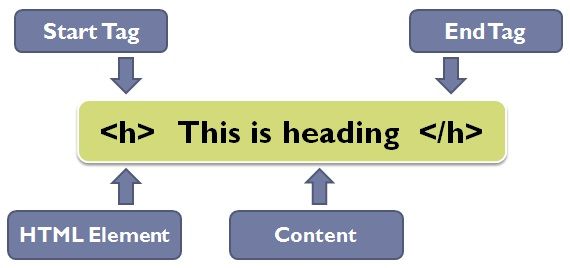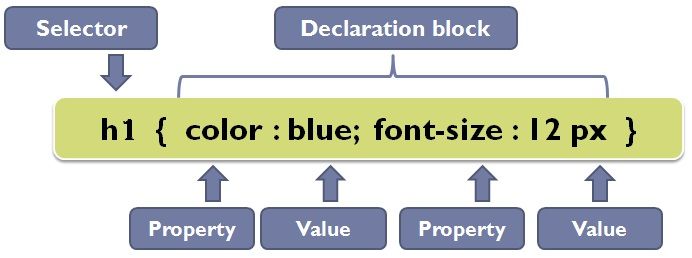 HTML and CSS are the core web scripting languages, the primary use of which is to create web pages and web application. The crucial difference between the two is that HTML is used for the creation of the webpages and CSS is used to control the styling and layout of web pages.
HTML and CSS are the core web scripting languages, the primary use of which is to create web pages and web application. The crucial difference between the two is that HTML is used for the creation of the webpages and CSS is used to control the styling and layout of web pages.
In HTML, firstly you write words then add elements or tags to it, which thereafter appear on your page. Through this way, the browser gets to know the heading of the page, beginning and ending of the paragraph, and so on.
In CSS, rules are used by utilising CSS properties. CSS properties are generally classified into two broad categories. First is the presentation which specifies the colour of the text, font type, font size, background colours, background images, etc. Second is layout defines the position of the different elements on the screen.
Using both HTML and CSS, a complete webpage interface is made.
Content: HTML Vs CSS
Comparison Chart
| Basis for comparison | HTML | CSS |
|---|---|---|
| Basic | Dictates content and structure of the web pages. | Modifies the design and display of the HTML elements. |
| Relevance | CSS can be used in HTML files. | HTML cannot be used in CSS style sheets. |
| Consist of | Tags surrounding content. | Selectors succeeded by a declaration block. |
| Methods of using | There are no defined methods. | Inline CSS code, Internal and external stylesheet any method could be used for implementing the code. |
Definition of HTML
HTML is a markup language for defining web documents(web pages). HTML expands to Hyper Text Markup language, it adds “markups” to Standard English text. “Hyper text” signify the links – Hyper links – that associates web pages with one another.
A markup language is a group of markup tags which define the page structure. Each HTML tag describes different document content. HTML is growing language which changes frequently, and a revised group of standards and specifications are brought permitting the simpler creation of appealing and more functional sites. HTML is not case sensitive.
Example
- HTML tags are fundamentally keywords (tag names) which is enclosed in angle brackets and usually come in a pairs.
<tagname> content </tagname>

- HTML element describes a specific section on a webpage.
- Content are the texts, links, images, or other information displayed on your webpage.
- Start tag is an HTML element used to indicate the beginning of the element.
- End tag closes the HTML element to differentiate individual elements.
Definition of CSS
CSS is an acronym for Cascading Style Sheets which permits you to create rules that specify the representation of the HTML elements on a screen. It is an addition to basic HTML that enables styling to your web pages.
CSS saves a lot of work by controlling the layout of several web pages all at one time. CSS styles can be implemented in three distinct ways to your website: inline, internal and external stylesheets.
Example
- CSS declarations rest within curly brackets, and each consist of two parts: property and its value, separated by a colon. You can define numerous properties in one declaration, each separated by a semi-colon.

- Selectors indicate which HTML element you want to style.
- Declaration includes property and value separated by a colon. Additionally, curly braces enclosing all declarations is known as Declaration block.
- Properties signify the aspects of elements you want to change.
- Values specify the settings you want to apply in the chosen properties.
Key Differences Between HTML and CSS
- HTML is the basic markup language which describes the content and structure of the web pages. On the other hand, CSS is the extension to the HTML which modifies the design and display of the web pages.
- HTML file can contain CSS code while CSS stylesheets can never contain HTML code in it.
- HTML comprises of tags surrounding content. Whereas CSS comprised of selectors succeeded by a declaration block.
Advantages of HTML
- Simple to use and have loose syntax (although, being too flexible will not abide by with standards).
- Widely used, established on nearly every website and supported by every browser.
- Analogous to XML syntax, which used to an increasing extent for data storage.
- It is free as you need not buy any software.
- Easy to learn and code even to beginners.
Advantages of CSS
- CSS conserves your time by writing CSS one time and reusing the same sheet in several pages.
- Pages consume less time for loading due to less the code.
- Easy to maintain, global changes are easy to employ.
- CSS has better styles to HTML and a much broader range of attributes.
- Provision of multiple device compatibility.
- Now HTML attributes are being deplored, and it is being advised to use CSS in all the HTML pages to make them compatible with future browsers.
- Supports offline browsing with the help of an offline cache.
- The script gives persistent platform independence and can support latest browsers as well.
Disadvantages of HTML
- As it is a static language, It cannot generate dynamic output.
- Offers limited security features.
Disadvantages of CSS
Fragmentation – CSS renders different dimensions with each browser. Programmers should consider and test all code across multiple browsers before taking any website, or mobile application live so that no compatibility issues would arise.
Conclusion
HTML and CSS both client side web scripting languages are used for creating web pages. Although they differ in many ways like syntactical structure, implementing methods, ease of use and features like attributes supported by the language. However, CSS is replacing HTML since it offers more features and flexibility.
Paidi.Jahnavi says
It is somewhat useful for me
Thank you